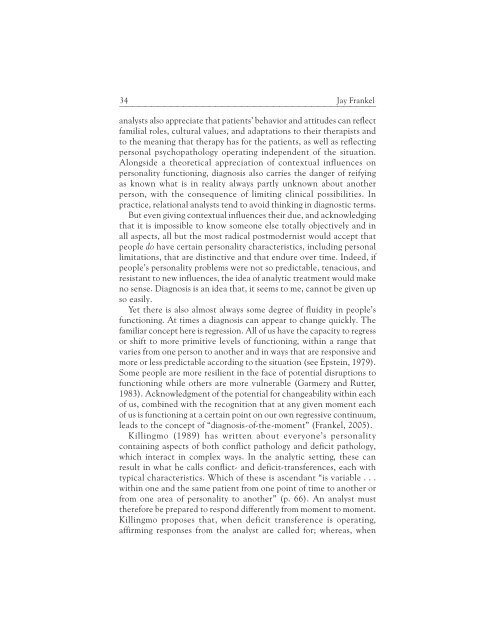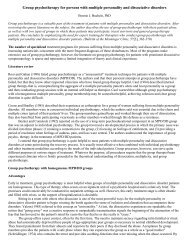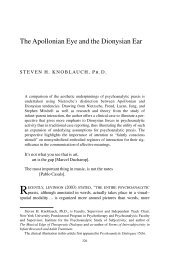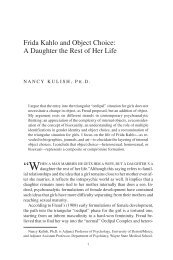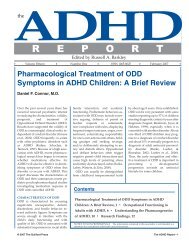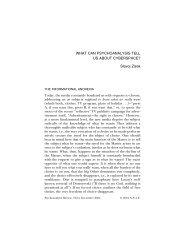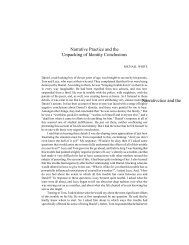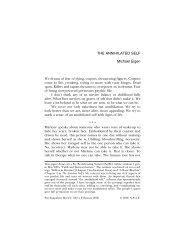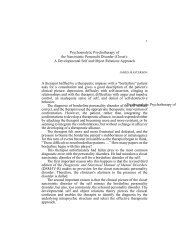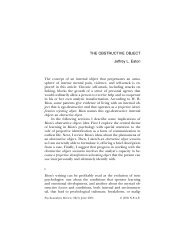What's a Good Object to Do? - PsyBC
What's a Good Object to Do? - PsyBC
What's a Good Object to Do? - PsyBC
You also want an ePaper? Increase the reach of your titles
YUMPU automatically turns print PDFs into web optimized ePapers that Google loves.
34 Jay Frankel<br />
⎯⎯⎯⎯⎯⎯⎯⎯⎯⎯⎯⎯⎯⎯⎯⎯⎯⎯⎯⎯⎯⎯⎯⎯⎯⎯⎯⎯⎯⎯⎯⎯⎯⎯⎯⎯⎯⎯⎯⎯<br />
analysts also appreciate that patients’ behavior and attitudes can reflect<br />
familial roles, cultural values, and adaptations <strong>to</strong> their therapists and<br />
<strong>to</strong> the meaning that therapy has for the patients, as well as reflecting<br />
personal psychopathology operating independent of the situation.<br />
Alongside a theoretical appreciation of contextual influences on<br />
personality functioning, diagnosis also carries the danger of reifying<br />
as known what is in reality always partly unknown about another<br />
person, with the consequence of limiting clinical possibilities. In<br />
practice, relational analysts tend <strong>to</strong> avoid thinking in diagnostic terms.<br />
But even giving contextual influences their due, and acknowledging<br />
that it is impossible <strong>to</strong> know someone else <strong>to</strong>tally objectively and in<br />
all aspects, all but the most radical postmodernist would accept that<br />
people do have certain personality characteristics, including personal<br />
limitations, that are distinctive and that endure over time. Indeed, if<br />
people’s personality problems were not so predictable, tenacious, and<br />
resistant <strong>to</strong> new influences, the idea of analytic treatment would make<br />
no sense. Diagnosis is an idea that, it seems <strong>to</strong> me, cannot be given up<br />
so easily.<br />
Yet there is also almost always some degree of fluidity in people’s<br />
functioning. At times a diagnosis can appear <strong>to</strong> change quickly. The<br />
familiar concept here is regression. All of us have the capacity <strong>to</strong> regress<br />
or shift <strong>to</strong> more primitive levels of functioning, within a range that<br />
varies from one person <strong>to</strong> another and in ways that are responsive and<br />
more or less predictable according <strong>to</strong> the situation (see Epstein, 1979).<br />
Some people are more resilient in the face of potential disruptions <strong>to</strong><br />
functioning while others are more vulnerable (Garmezy and Rutter,<br />
1983). Acknowledgment of the potential for changeability within each<br />
of us, combined with the recognition that at any given moment each<br />
of us is functioning at a certain point on our own regressive continuum,<br />
leads <strong>to</strong> the concept of “diagnosis-of-the-moment” (Frankel, 2005).<br />
Killingmo (1989) has written about everyone’s personality<br />
containing aspects of both conflict pathology and deficit pathology,<br />
which interact in complex ways. In the analytic setting, these can<br />
result in what he calls conflict- and deficit-transferences, each with<br />
typical characteristics. Which of these is ascendant “is variable . . .<br />
within one and the same patient from one point of time <strong>to</strong> another or<br />
from one area of personality <strong>to</strong> another” (p. 66). An analyst must<br />
therefore be prepared <strong>to</strong> respond differently from moment <strong>to</strong> moment.<br />
Killingmo proposes that, when deficit transference is operating,<br />
affirming responses from the analyst are called for; whereas, when


